Learn how to lower your carbon footprint with diet in this in-depth guide on how to eat a climate-friendly diet.
According to recent research, diet may be the most significant impact you can make over your lifetime on climate change—even more important than the choice of car you drive.1 Learn how to eat a climate-friendly diet that can help you lower your carbon footprint, while promoting optimal health.
A Hot Planet
Things have been heating up on the planet over recent years. Although it seems to have been on a low simmer for decades, recent evidence sharply illustrates the plight of climate change. Glaciers are shrinking by miles, drought has led to drops in water levels—42% in Arizona’s Lake Powell between 1999 and 2014—and precipitation may decline by 20-25% over most of California, Southern Nevada, and Arizona by the end of the century.2
One of the most destructive and deadly results is the increase in wildfires that have been ravishing the country. California’s Camp Fire in 2019 was the state’s deadliest wildfire, taking 85 lives and destroying 14,000 homes. And in 2020, the state coined a new term—gigafire—to describe a blaze that burns at least a million acres of land in an already record-setting year of wildfires. The cause is simple—hotter temperatures cause drier land, which creates a parched atmosphere.
The solution is not so simple. The most recent period of the Earth’s history has been defined as the Anthropocene, a period during which human activity has been the dominant influence on climate and the environment. Scientists debate whether the Anthropocene began in the 1800s with the Industrial Revolution, when human activity impacted carbon and methane in the atmosphere; 1945, when humans tested and dropped the first atomic bombs, releasing radioactive particles; or 1950 with the Great Acceleration, the dramatic and continuous surge in growth measured by human activity that continues today. Regardless of when it began, the Intergovernmental Panel on Climate Change (IPCC) recommends a 1.5-degree Celsius safe limit for global warming increase above pre-industrial levels. This requires a 70-95% reduction in current greenhouse gas emissions (GHGes) by the year 2050.3

Eating for Health, and the Planet
More and more, people are becoming aware of the connection between their diet choices and environmental footprint. In fact, most people think beyond their own health to include the health of the planet. According to the International Food Information Council (IFIC) Food and Health Survey, 2019, 54% of consumers say it’s important that foods they purchase and consume are sustainably produced.4 People are also becoming more aware of the need for a sustainable food system, where food is produced using techniques that protect the environment, public health, communities, natural ecosystems, and animals, and results in a reliable food supply for future generations.
The modern food system over the past 50 years has vastly changed the agricultural system and our dietary patterns. The result of these changes, such as larger-scale farms, higher GHGes, and loss of biodiversity, contributed to the foods that became part of the Western diet, which is high in highly processed foods, animal foods, and fast foods, and low in healthy, whole plant foods. These foods in the Western diet have made a direct impact on communities and the environment.
The Western diet negatively affects health, agriculture, and the environment, according to research. Traditional diets rely on biodiversity; Western diets rely on a lower variety of foods. According to a study published in the December 2018 Frontiers in Sustainable Food Systems, 75% of the world’s food comes from just 12 plant species and fewer than five animal species, yet we could be consuming from 10,000 plant species, 2,500 animal species, and a greater diversity of fungi and algae.5 Dietitians understand that negative health consequences of consuming highly processed foods, refined sugars, and refined grains over the last 40 years is associated with an increase in diseases such as diabetes, overweight, and obesity. However, these eating patterns have also impacted planetary health. Overall, today’s agricultural methods increase the use of fossil fuels, GHGes, and land-use conversion (converting forest ecosystems to agriculture).5 Compared to other diet patterns, such as the Mediterranean diet and plant-based dietary patterns, the Western diet has a much heavier environmental footprint.
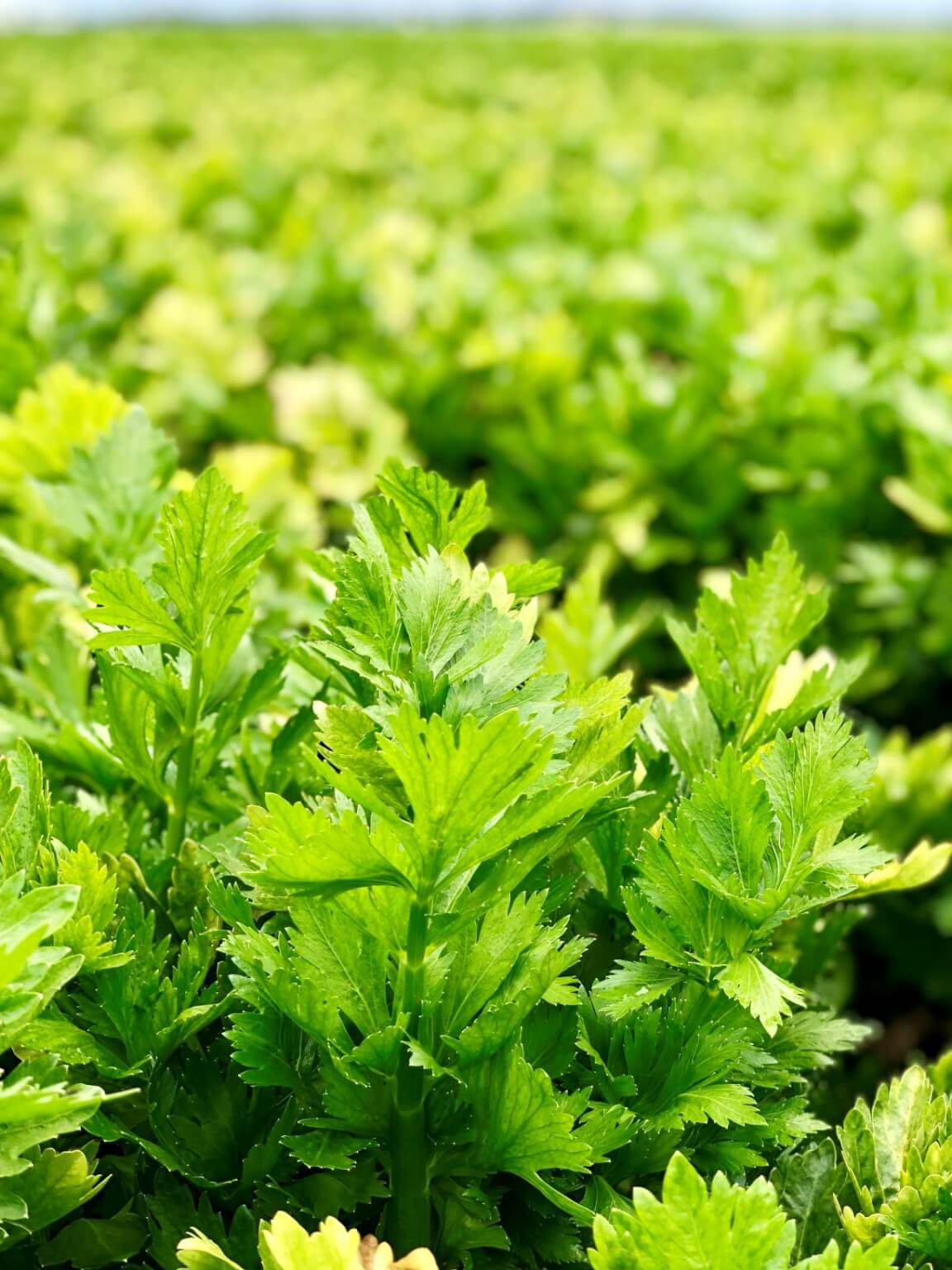
Feeding the world’s 7.8 billion people devastates terrestrial and aquatic ecosystems, drains water resources, and drives climate change, according to research. A study in the December 2018 Frontiers in Sustainable Food Systems, reported that the global food supply chain is responsible for 26% of the planet’s GHGe, 32% of its terrestrial acidification (decline in soil fertility due to acidic nutrients), and 78% of its eutrophication (excessive nutrient richness in bodies of water, often from nutrient runoff resulting in dense plant growth and loss of animal life). The farm stage of food production alone makes up 61% of foods’ GHGes and uses 43% of the world’s ice- and desert-free land, and more than two-thirds of its freshwater.1 This is even more concerning when you consider that the global population is set to grow by 2 billion in the next 30 years.
From the farm, food travels via air, water, and land to be manufactured and prepared and packaged before it’s delivered for storage and then distributed to retailers. This is where the consumer enters the food chain, spending energy and using resources purchasing food, transporting it home, cooking and eating it, and ultimately disposing it as waste and recycling that are mostly transported to a landfill where about 30% of the U.S. food supply is tossed.6

Soil and Sustainability
The health of the soil is intertwined in human and planetary health. Soil microbiomes are a complete set of microbes that live in soil ecosystems. These soil microbial communities are essential for sustaining life on the planet, including the cycling of carbon and other nutrients and plant growth, and they increase resistance to crop stresses.7
Agriculture threatens soil communities through climate change, soil degradation, and poor land management, which is harmful to the soil microbiome. Agrochemicals, such as inorganic fertilizers and pesticides, lead to severe impacts on soil ecology.8 Healthy soils promote soil carbon sequestration, which removes carbon dioxide from the atmosphere and stores it in a soil carbon pool through plants in the form of soil organic carbon (SOC). Unfortunately, the conversion of natural ecosystems to agriculture releases that carbon into the atmosphere. However, reduced tillage, erosion control, organic amendments, and cover crops can increase SOC.9
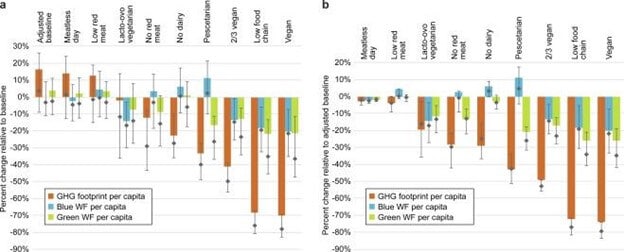

Diet Patterns
Research has consistently shown that plant-based dietary patterns—the more plant-based the better the benefit—are linked with lower environmental impact compared to Western diet patterns. Interestingly, research of nine diets aligned with criteria for a healthy diet specific to 140 countries found shifts in diets to mostly plants and modest amounts of low-food chain animals, like forage fish, mollusks, and insects, had similar impacts on GHGe and water footprints as vegan diets. While vegan diets had the greatest benefit, the next best eco-impacts were low-food chain, two-thirds vegan, pescatarian, no dairy, no red meat, vegetarian, reducing meat, and meatless one day a week, which had the smallest degree of benefit.10
Converting from a Western diet to a Mediterranean eating style may also significantly reduce impact, reducing GHGe by 72%, land use by 58%, energy consumption by 52%, and water consumption by 33%.11 This lower footprint, research shows, is due to the Mediterranean diet’s lower levels of meat.12 According to Italian researchers, if an average Italian family consumed a vegetarian diet, it would reduce its annual carbon dioxide 614 kilograms per year, the equivalent of the 3,175 kilometers released by an average European car.13

Other sustainable dietary patterns can potentially have environmental and health benefits over the Western diet. Research shows that adopting one of 14 common sustainable dietary patterns (ranging from vegan and vegetarian to Mediterranean and New Nordic) could result in reductions as high as 80% of GHGes and land use, and 50% of water use. The reductions were mostly proportional to the degree of animal-based food restriction.14

Data from the Adventist Health Study and California state agricultural data used to calculate dietary consumption patterns compared to environmental effect showed that nonvegetarian diets used 2.9 times more water, 2.5 times more primary energy, 13 times more fertilizer, and 1.4 times more pesticides than vegetarian diets. The greatest contribution to these differences, which has also been noted in many other population studies, was beef consumption.12 The EPIC-Oxford cohort study compared the GHGes between meat-eaters, fish-eaters, vegetarians, and vegans in the UK. Dietary GHGes in kilograms of carbon dioxide equivalent for high meat-eaters was 7.19, twice that of vegans, which was 2.89. Low meat-eaters was 4.67, fish-eaters was 3.91, and vegetarians was 3.81.15
Eco-Impact of Livestock
Livestock—from genetics, to food production, to feedlot, to meat processing, to distribution, to plate—is responsible for large amounts of GHGes, including methane and nitrous oxide, which have greater global warming potential than carbon dioxide. Livestock also contributes to environmental degradation, such as deforestation, land degradation and erosion, loss of biodiversity, increased water use, water pollution, and eutrophication.16 Further, the rise in global intake of animal foods pushes the planetary boundaries to feed people.17
Of the quarter of global GHGes that come from food, more than half of those emissions come from animal products—58% from animal products, compared to 42% from other foods. Half of all farmed animal emissions come from beef and lamb1. The IPCC Report uses global average data to estimate that the removal of animal-sourced foods from human diets by 2050 could avoid eight gigatons of GHGe per year. Limiting consumption of meat or seafood to once a month accomplishes about three-quarters of that goal, suggesting that reducing meat consumption would have huge ecosystem implications.18

Greener Protein Options
Far less energy is needed to produce the same amount of protein from high-protein plant foods, such as soy and pulses, than animal foods.19 Pulses are among the most sustainable plant proteins. They have one of the lowest carbon footprints, are drought tolerant, and enrich the soil through fixing nitrogen, which reduces the need for fertilizers. Pulses also aid food security because half of all pulses produced occurs in developing nations, and because they increase crop diversity, they decrease risk to farmers. Growing pulses can help step up agricultural production to help reach the 70% increase in food production we will need to feed the world by 2050.
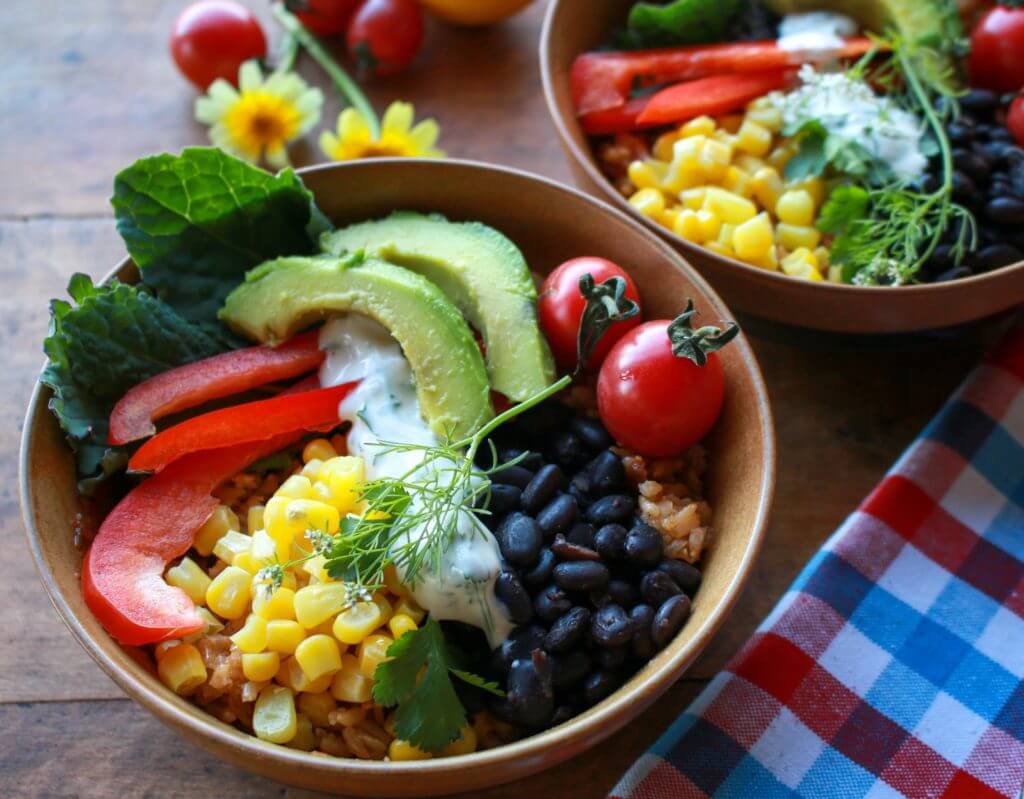
Whole grains are another sustainable protein-containing plant food. According to the Whole Grains Council, eating more grain-based meals could feed more people with less land, compared to the 75% of global agricultural land that is used for animal products that only supply 17% of our food in calories. And rotating crops with whole grains, like barley, oats, and rye, in the off season can deliver nutrients back to the soil and help protect against soil erosion.20 Whole grains play an integral role in the EAT-Lancet Planetary Health Diet, a global diet developed by the EAT-Lancet Commission which is healthy for both people and planet. The diet recommends half a plate of vegetables and fruit, and half primarily whole grains, plant proteins, unsaturated plant oils, and modest animal protein21.
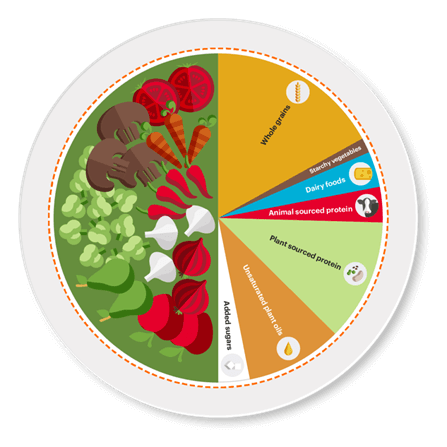
Global Meat Reductions
Countries around the world, like the Netherlands, are recommending reducing red meat intake and increasing plant foods.22 China, who dramatically increased meat consumption (their average intake of 13 kilograms per person per year soared to 63 kg) along with prosperity, has goals in their dietary guidelines to cut meat consumption in half.23 And the British Dietetic Association’s Environmentally Sustainable Diet (One Blue Dot) recommendations for the UK call for reducing red meat to less than 70 grams per person per day, along with avoiding processed meats, and prioritizing high-protein plant foods, such as beans, lentils, soy, nuts, and seeds.24

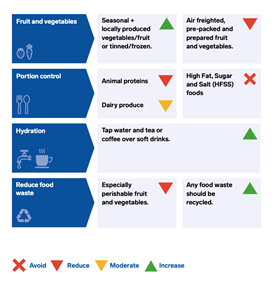
Targeting Nutritious Foods
Targeting healthful, nutritious foods, such as whole grains, legumes, vegetables, and fruits, is better for human health and the health of the planet. Low-nutrient foods not only require more energy to produce, they provide few nutrients and do not promote optimal health. The use of resources, such as land, water, fossil fuels, and pesticides to produce foods with poor nutritional quality is not sustainable. Unfortunately, nearly one-third of calories eaten in the US diet come from this type of junk food.25 And because people are not cooking as much at home—90% of Americans say they don’t cook—highly processed foods are largely the way people shop today, so it’s important to recommend products that feature whole, nutrient-rich foods.26 Drinking tap water is the most sustainable beverage option, though coffee and tea are good options. Soft drinks and fruit juices are the third biggest contributor to GHGes.27
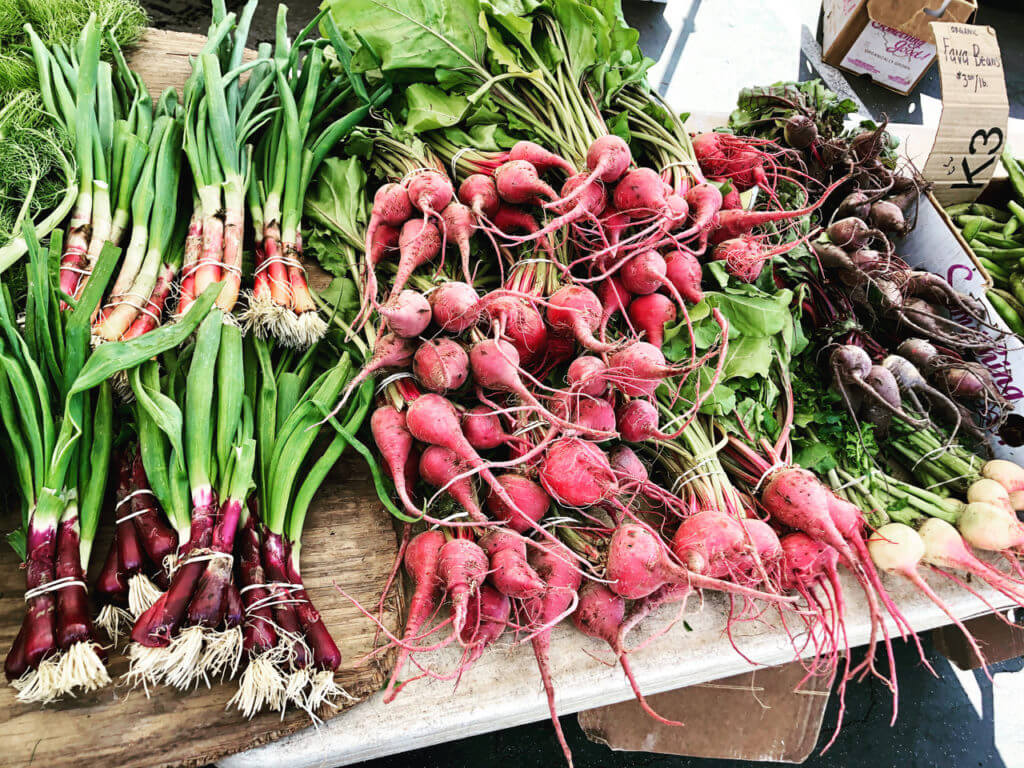
Stop Food Waste
Between 30% and 40% of the U.S. food supply is wasted, and consumers are directly responsible for upwards of two-thirds of that food waste,6 which fills one-third of landfills, where it creates GHGes. That’s a lot of land, water, energy, synthetic inputs, such as fertilizer and pesticides—and carbon emissions—to produce food that is never consumed. Minimizing food packaging by skipping single-use, disposable straws and cups and eating fast food less often is a sustainable strategy. The average family eats fast food 150 times per year, which creates 1.8 million tons of fast food packaging per year.28
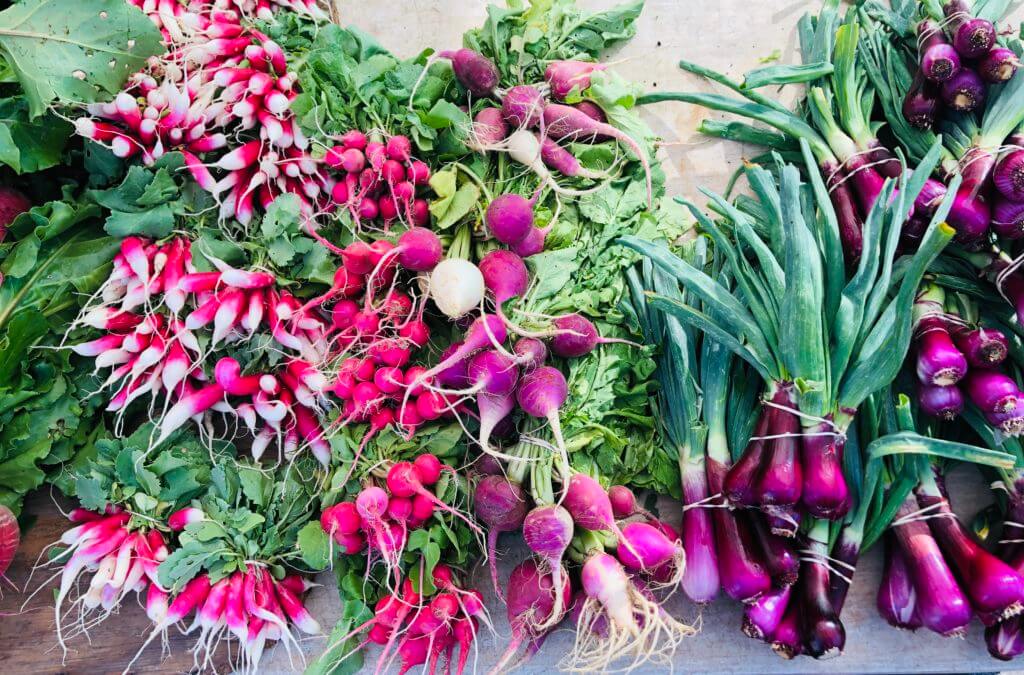
Eat Seasonally and Sustainably
According to the WorldWatch Institute, food typically travels 1,500 – 2,500 miles from farm to plate. A study in Iowa tracked 2,211 miles for one carton of yogurt (milk, sugar, strawberries) to get to the processing plant. In a Swedish study, a typical Swedish breakfast of apple, bread, butter, cheese, coffee, cream, orange juice, and sugar, traveled the circumference of the Earth to get to the plate!29 Eating seasonally is better for the environment because it reduces the distance food travels, which means less fuel and fewer GHGes. Eating with the seasons also supports local agriculture, contributes to food security, and encourages face to face interactions in the community. One of the most sustainable things people can do is to grow some of their own food, by planting herbs, edible landscaping, shrubs, and trees. They also can add a composting bin to take it full circle.

Top Tips for a Healthy Plant-Based Eating Style
Check out my top tips on how to eat a more plant-based diet.
- Start the day right. Go veggie at breakfast.
- Join the Meatless Monday bandwagon.
- Shop for plants first. Instead of planning your menu around meat, plan it around plants.
- If you eat meat, use it as a seasoning. Cut down on animal food intake while pushing plants by using meat as a flavoring in dishes instead of the main event.
- Create a plant-based pantry list. Many plant-based foods like beans and whole grains are shelf-stable, convenient, and economical.
- Get cooking! Plan at least one night a week to try a new vegetarian recipe.
- Keep it simple. Not every meal has to involve cookbooks and cutting boards; it can be as easy as black bean burritos, vegetarian chili, or hummus pita sandwiches.
- Try global flair. Some cultures know how to do vegetarian meals right!
- Convert your favorite dishes. Turn your favorite meat-based recipes veggie for an easy dinner solution.
- Dust off your slow-cooker. Just throw in veggies, herbs, vegetable broth, canned tomatoes, whole grains, and dried beans; then turn the dial on.
- Try plant-based dairy products. Try more plant-based alternatives for milk, yogurt, and cheese.
- Think “yes.” Don’t dwell on what you can’t have, think about what you can have!
For other blogs on sustainable eating, check out:
Nourishing Biodiversity in Your Diet
Green Up Your Kitchen Practices for a Healthier Planet
4 Ways to Eat for the Environment
Written by Sharon Palmer, MSFS, RDN; Images by Sharon Palmer, MSFS, RDN
References
- Poore, J., & Nemecek, T. Reducing food’s environmental impacts through producers and consumers. New York, NY. Science. 2018;360(6392), 987–992. https://pubmed.ncbi.nlm.nih.gov/29853680/.
- How our planet has changed over time. CNN. https://www.cnn.com/interactive/2019/09/world/climate-change-before-after/. Published 2019. Accessed October 14, 2020.
- The nine planetary boundaries. Stockholm Resilience Centre. https://www.stockholmresilience.org/research/planetary-boundaries/planetary-boundaries/about-the-research/the-nine-planetary-boundaries.html. Accessed October 14, 2020.
- Food and Health Report. Foodinsight.org https://foodinsight.org/wp-content/uploads/2019/05/IFIC-Foundation-2019-Food-and-Health-Report-FINAL.pdf. Accessed October 14, 2020.
- Mejía, N. V., Reyes, R. P., Martinez, Y., Carrasco, O., & Cerritos, R. Implications of the Western Diet for AgriculturalProduction, Health and ClimateChange. Frontiers in Sustainable Food Systems. 2018. doi:10.3389/fsufs.2018.00088.
- Why Should We Care About Food Waste? U.S. Department of Agriculture. https://www.usda.gov/foodlossandwaste/why. Accessed October 14, 2020.
- Jansson, J. K., & Hofmockel, K. S. The soil microbiome—from metagenomics tometaphenomics. Current Opinion in Microbiology. 2018;43, 162–168. doi:10.1016/j.mib.2018.01.013.
- Kalia, A. & Gosal, S.K. Effect of pesticide application on soil microorganisms, Archives of Agronomy and Soil Science. Science and Education. 2011;(57)6, 569-596. http://www.sciepub.com/reference/45732. Accessed October 12, 2020.
- Ontl, T.A. & Schulte, L.A. Soil Carbon Storage. Nature Education Knowledge. 2012; 3(10), 35. https://www.nature.com/scitable/knowledge/library/soil-carbon-storage-84223790/.
- Kim, B. F., Santo, R. E., Scatterday, A. P., et al. Country-specific dietary shifts to mitigate climate and water crises. Global Environmental Change. 2019;62:101926. doi:10.1016/j.gloenvcha.2019.05.010
- Sáez-Almendros, S., Obrador, B., Bach-Faig, A., & Serra-Majem, L. Environmental footprints of Mediterranean versus Western dietary patterns: beyond the health benefits of the Mediterranean diet. Environmental Health. 2013;12(1). doi: 10.1186/1476-069x-12-118.
- Marlow, H. J., Hayes, W. K., Soret, S., et al. Diet and the environment: Does what you eat matter? American Journal of Clinical Nutrition. 2009; 89(5). https://doi.org/10.3945/ajcn.2009.26736Z.
- Pairotti M.B., Cerutti A.K., Martini F., Vesce E., Padovan D., Beltramo R. Energy consumption and GHG emission of the Mediterranean diet: a systemic assessment using a hybrid LCA-IO method. Journal of Cleaner Production. 2015;103:507-516. doi:10.1016/j.jclepro.2013.12.082.
- Aleksandrowicz, L., Green, R., Joy, E. J. M., Smith, P., & Haines, A. The Impacts of Dietary Change on Greenhouse Gas Emissions, Land Use, Water Use, and Health: A Systematic Review.PlosOne. 2016;11(11). doi:10.1371/journal.pone.0165797.
- Scarborough, P., Appleby, P. N., Mizdrak, A., Briggs, A.D.M., et al. Dietary greenhouse gas emissions of meat-eaters,fish-eaters, vegetarians and vegans in the UK. Climatic Change. 2014;125(2), 179–192. https://www.researchgate.net/publication/263353807_Dietary_greenhouse_gas_emissions_of_meat-eaters_fish-eaters_vegetarians_and_vegans_in_the_UK.
- Steinfeld, H., Gerber, P., Wassenaar, R., Castel, V., Rosales, M., & deHaan, C. Livestock’s long shadow: Environmental issues and options. Rome, Italy: Food and Agriculture Organization of the United Nations. 2006. http://www.fao.org/publications/card/en/c/9655af93-7f88-58fc-84e8-d70a9a4d8bec/.
- Pelletier N & Tyedmers P. Forecasting potential global environmental costs of livestock production 2000-2050. Proceedings of the National Academy of Sciences. 2010;107(43):18371-18374. doi:10.1073/pnas.1004659107.
- Our Future on Earth 2020. Future Earth. https://futureearth.org/publications/our-future-on-earth/. Published 2020. Accessed October 14, 2020.
- Sabaté J, Soret S. Sustainability of plant-based diets: back to the future. The American Journal of Clinical Nutrition. 2014;100(suppl_1). doi:10.3945/ajcn.113.071522.
- Sustainable Food. Whole Grains Council. https://wholegrainscouncil.org/sites/default/files/atoms/files/WG_SustainableFood_infographic.pdf. Accessed October 14, 2020.
- Willett W, Rockström J, Loken B, et al. Food in the Anthropocene: the EAT–Lancet Commission on healthy diets from sustainable food systems. The Lancet. 2019;393(10170):447-492. doi:10.1016/s0140-6736(18)31788-4
- Food-based dietary guidelines–The Netherlands. Food and Agriculture Organization of the United Nations. http://www.fao.org/nutrition/education/food-dietary-guidelines/regions/countries/Netherlands/en. Published 2015. Accessed October 14, 2020.
- Milman O, Leavenworth S. China’s plan to cut meat consumption by 50% cheered by climate campaigners. The Guardian. https://www.theguardian.com/world/2016/jun/20/chinas-meat-consumption-climate-change. Published June 22, 2016. Accessed October 14, 2020.
- Eating Patterns for Health and Environmental Sustainability. BDA. https://www.bda.uk.com/uploads/assets/539e2268-7991-4d24-b9ee867c1b2808fc/421de049-2c41-4d85-934f0a2f6362cc4a/one%20blue%20dot%20reference%20guide.pdf. Accessed October 14, 2020.
- Yang, S. Nearly one-third of the calories in the US diet comprised of junk food, researcher finds. 06.01.2004 – Nearly one-third of the calories in the US diet comprised of junk food, researcher finds. UC Berkeley News. https://www.berkeley.edu/news/media/releases/2004/06/01_usdiet.shtml. Published 2004. Accessed October 14, 2020.
- Martin, E. 90% of Americans don’t like to cook-and it’s costing them thousands each year. CNBC. https://www.cnbc.com/2017/09/27/how-much-americans-waste-on-dining-out.html. Published September 27, 2017. Accessed October 14, 2020.
- Kamp, M.E.V.D., Seves, S.M., Temme, E.H.M. Reducing GHG emissions while improving diet quality: exploring the potential of reduced meat, cheese and alcoholic and soft drinks consumption at specific moments during the day. BMC Public Health. 2018;18(1). doi:10.1186/s12889-018-5132-3.
- Routley, N. Ranked: Biggest Fast Food Chains in America. Visual Capitalist. https://www.visualcapitalist.com/biggest-fast-food-chains-in-america/. Published December 7, 2019. Accessed October 14, 2020.
- Worldwatch Institute. Climate Action Network International. http://www.climatenetwork.org/profile/member/worldwatch-institute. Accessed October 14, 2020.









